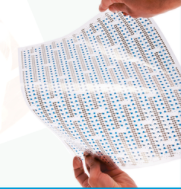
Is it finally time for printed temperature sensors? – Electronic Products & Technology
Think of a temperature sensor – and a traditional glass thermometer, or perhaps a small thermistor would probably spring to mind. However, a new class of temperature sensors is rapidly emerging that offers spatial resolution together with a thin-film format.
This new class of temperature sensors is made from a solution-processable semiconductor that is coated between conductive rows and columns in a passive matrix architecture. Both the temperature sensing semiconducting layer and the conductors can be printed onto flexible substrates such as PET, enabling low-cost production of a wide range of shapes and sizes.
Why now?
With the ability to provide spatially resolved temperature resolution at a low cost, it might seem surprising that printed temperature sensors are not already widespread. IDTechEx identify two main reasons. Firstly, existing temperature sensors are cheap, well understood, and very small. While conventional inorganic thermistors or platinum resistive temperature detectors (RTDs) are certainly not flexible, they are generally so small that incorporating them into a component or device doesn’t impose any form factor constraints.
Secondly, thermal diffusion is quite slow. This means that thermal gradients are usually very gentle, certainly when compared to spatial variation in force or light intensity for example. As such, introducing measurement with fine spatial resolution is unnecessary in many cases, since a few thermistors or RTDs embedded in a thermally conductive layer provide equivalent insights.
However, while both of these factors remain true, emerging application areas mean that a combination of spatially resolved temperature measurement, low-cost roll-to-roll (R2R) production, and flexible thin-film format mean that demand for printed temperature sensors is forecast to grow substantially over the next decade, with an increasing number of companies developing this technology.
This new class of temperature sensors is made from a solution-processable semiconductor that is coated between conductive rows and columns in a passive matrix architecture. Both the temperature sensing semiconducting layer and the conductors can be printed onto flexible substrates such as PET, enabling low-cost production of a wide range of shapes and sizes.
Why now?
With the ability to provide spatially resolved temperature resolution at a low cost, it might seem surprising that printed temperature sensors are not already widespread. IDTechEx identify two main reasons. Firstly, existing temperature sensors are cheap, well understood, and very small. While conventional inorganic thermistors or platinum resistive temperature detectors (RTDs) are certainly not flexible, they are generally so small that incorporating them into a component or device doesn’t impose any form factor constraints.
Secondly, thermal diffusion is quite slow. This means that thermal gradients are usually very gentle, certainly when compared to spatial variation in force or light intensity for example. As such, introducing measurement with fine spatial resolution is unnecessary in many cases, since a few thermistors or RTDs embedded in a thermally conductive layer provide equivalent insights.
However, while both of these factors remain true, emerging application areas mean that a combination of spatially resolved temperature measurement, low-cost roll-to-roll (R2R) production, and flexible thin-film format mean that demand for printed temperature sensors is forecast to grow substantially over the next decade, with an increasing number of companies developing this technology.
www.ept.ca



